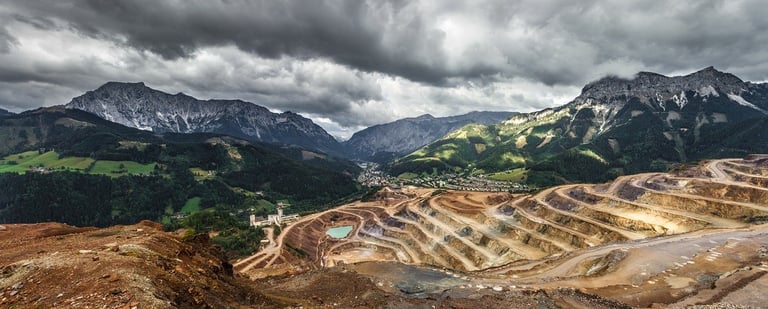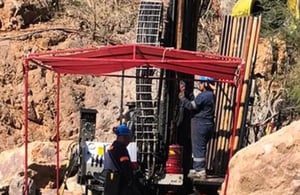Metal Tiger PLC (LON:MTR) Chief Executive Officer Michael McNeilly caught up with DirectorsTalk for an exclusive interview to discuss their T3 Pre-Feasibility Study results
Q1: You have announced the results of your T3 Botswana Prefeasibility study, what are the key highlights from this?
A1: The key highlights are that we’ve published two cases, a base case, which is obviously the one which everybody should rely upon from an investment point of view, and then a more optimistic expansion case.
The base case gives a US$730 million EBITDA over 9 years giving a NPV of $281 million pre-tax using $3.20 a pound per copper for most of the life of the mine, with $3.20 for the first 2 years of production and it falls back down to $3 at an 8% discount rate. We’re getting an excellent IRR of 39% and the capex has only slightly increased from what we published in the scoping study so it’s at $155 million and that’s split over 3 years.
So, you’ve got US$9 million which is budgeted for in 2018 and obviously that’s for 100% of the project so 30% of that would be for Metal Tiger and that’s sort of for your long-lead items that you might need to bring in and then $101 million for the second year and $45 million the third year so you’d start your bank financing from next year really. Obviously very good C1 costs within that of $1.22 a pound of copper so we’re very encouraged by the results.
I think that it’s important that the market takes away from this that Metal Tiger’s attributable NPV, just on the base case, is circa £60 million, they’ve used in my opinion very conservative forecast for copper. If you think about it, BHP Billiton plc (LON:BLT) is expecting the copper market to remain finely balanced over the next few years and they point to several strong longer-term fundamentals, particularly in the renewables and the electric vehicles space driving long-term copper demand. You could also make the argument that there’s the risk of substitution, that certainly in China it doesn’t seem like anything’s moving in that direction currently. Finally, just to quickly cap off, the upside expansion case uses measures indicated as inferred resource from year 3 or 4 so the first 3 years are just using proven probable.
So, a lot of investors need to note that between this and the scoping study, we’ve actually used less resource because we’re only using the proved and probable so in the expansion case we’re using more of the resource. The interesting thing to note as well is that the capex essentially remains the same until about year 4 and you only make a decision in year 2 whether you’re going to expand the plant from 2.5 million tonnes per annum to 4 million tonnes per annum and that extra capital cost can be taken care of from free cash flow.
So, it’s all very positive and also what’s not mentioned in that expansion case is that extra capex, obviously, you would be able to write off against your tax because these are pre-tax figures so actually the expansion case, expanding that plant and also spending that money makes a lot of sense in the future. Should it make sense to go that route, and obviously there’s infill drilling going on now to try and update the resource, to try and move more inferred resource into indicated and measured.
Q2: Just going back to the 2 cases, can you explain the difference between the base case and the expansion case in terms of capex?
A2: So, there’s $155 million capex in both, initially, and then there’s additional expansion capital of $37 million for the plant upgrade and then there’s a slight difference between the sustaining capex and the upside case is $54 million and I believe in the base case it’s $31 million, I think, for the sustaining capex.
Q3: Can you tell us about the timing of the major works on T3?
A3: This year is obviously going to be focussed on some infill drilling at T3, testing the extensions for underground potential and then obviously the PFS work which we’ve agreed as a joint venture to progress with.
Of course, what’s more exciting in the short term is the fact that the EMP has been lodged with the government, this is for the environmental permission to commence drilling over T3 dome which, if you recall, we flew all that AEM and we’ve got about 19-20 targets which we will look to go drill the second we can. MOD, our joint venture partner, is confident that that will be approved in March, so we can start getting drill rigs on to that in March/April which is obviously very exciting because that’s all within truckable distance of the T3 asset.
What we’re really hoping to prove is that just around T3, there are other similar assets or viable copper deposits nearby and I think what’s coming even more later in the year will be environmental approvals over T20 where we’re looking to fly AEM to identify some targets there with the soils and the magnetics that we’ve already completed. That is obviously quite a way away, over 100 kilometres away from the T3 deposit heading towards Ghanzi, and that in essence will show, if we find some copper there, the extent of this copper belt and the potential.
So, around T3 will show there’s a larger potential project there and also will help towards showing the extent of the copper belt but also if you find something similar that far away, over at T20, then that really does start to peak the interests of your mid-cap copper producers and potentially larger.
Q4: Now, you also announced that you have fully sold your position in Kingsgate, and last week you invested in Thor Mining, are there further company investments planned?
A4: We are looking at other investment opportunities, we haven’t made any decisions on that yet. Obviously for us, we have to be quite conscious of our working cap position, we want to prioritise Botswana first and foremast as obviously we’ve had an exciting confirmation of what we already knew was there and that’s been de-risked heavily.
Also, we know and are hopeful that there will be vastly increased expenditure on exploration and that’s where I see tremendous value being added to MOD and Metal Tiger in what should be a relatively short period of time.
Of course, we like to take advantage of investment opportunities because cash is, ultimately, a redundant asset and you want to be making returns with that and managing that against your ongoing commitments.
Q5: Finally, what are Metal Tiger’s plans for 2018?
A5: Again, I guess to reiterate, prioritise and focus on ensuring that our stake in MOD is well positioned.
There’s really 3 outcomes that one can envisage for our 30% stake, one is a potential consolidation of our project stake with MOD and obviously that’s something that would potentially work quite well and be accretive to Metal Tiger but also be accretive or value-neutral to MOD. So, there’s a lot of sense in doing that and obviously everybody likes to see 100% of the project in one house, so to speak.
The second thing is just to continue to fiancé this and our cash balance and liquid assets are very strong and we’re very confident of being able to fund our portion of the commitments, certainly for 2018.
The third, who knows what will happen this year in terms of exploration, we’re always watching to see if somebody takes an interest in us and in MOD. For the time being, I think that could happen sooner rather than later if there’s exploration success.
So, for the time being the focus has to be on the option of exploring, consolidation and/or continuing to develop the project.








































